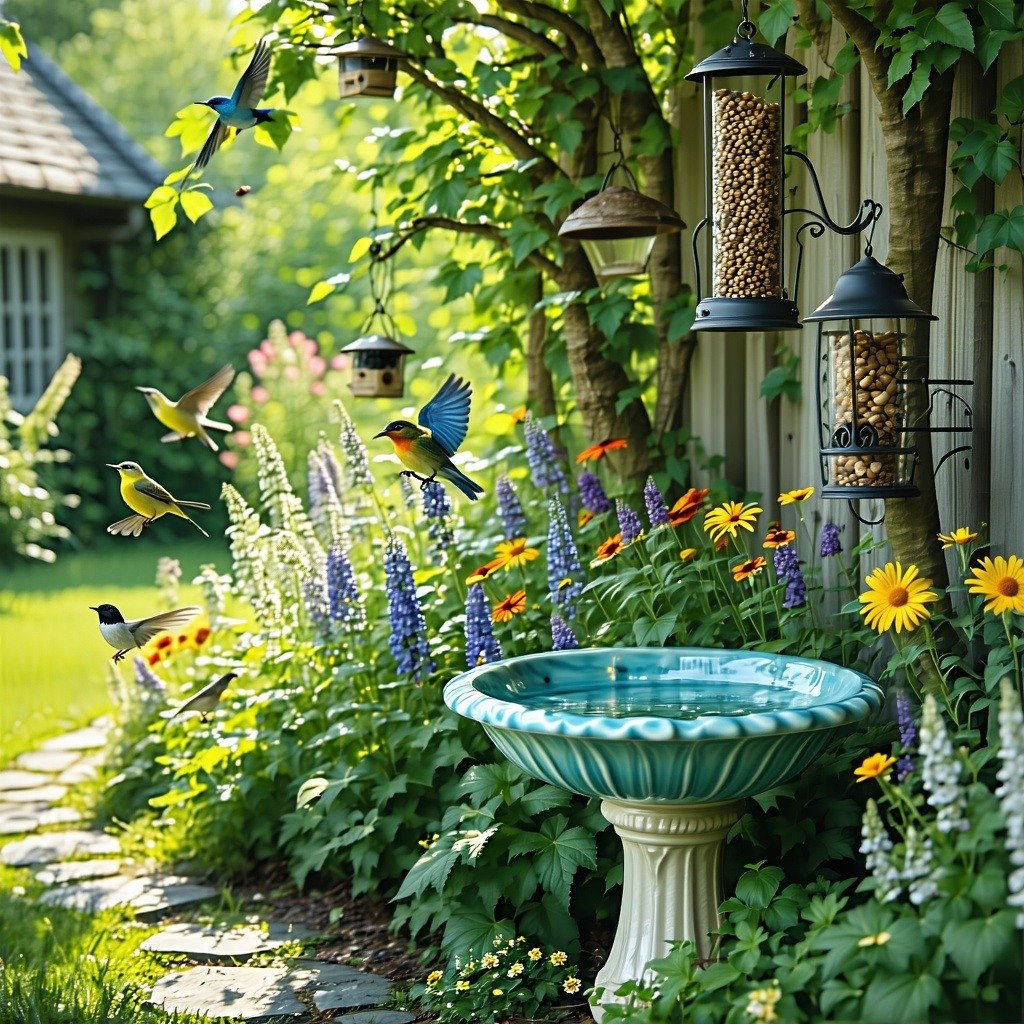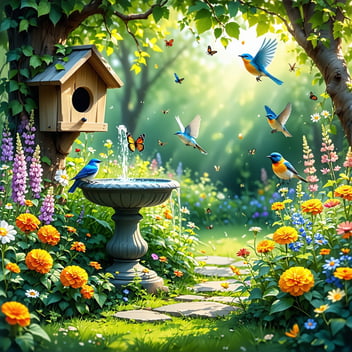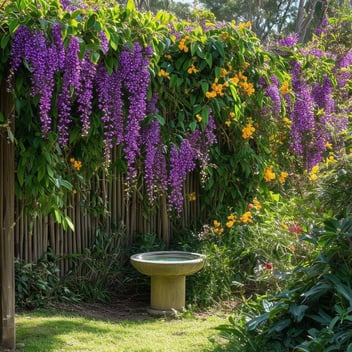Creating Wildlife Havens: Birdbaths, Feeders, and Bee Hotels
In an era where urbanization encroaches upon natural habitats, our gardens can serve as vital sanctuaries for local wildlife. By thoughtfully incorporating elements such as birdbaths, feeders, and bee hotels, we not only enhance the biodiversity of our surroundings but also enjoy the myriad benefits of coexisting with nature.
Birdbaths: Quenching Thirst and Encouraging Avian Visitors
Water is a fundamental necessity for birds, serving purposes beyond mere hydration; it aids in feather maintenance and thermoregulation. Introducing a birdbath into your garden can significantly increase avian activity.
Selecting the Ideal Birdbath
Opt for birdbaths with gently sloping sides and a maximum depth of 5 centimeters to accommodate various bird species safely. Materials such as glazed ceramic or concrete are durable and provide stable footing.
Optimal Placement for Safety and Accessibility
Position the birdbath in a shaded area to prevent water from overheating and to provide a cool respite. Ensure it's placed near shrubs or trees, offering birds quick access to cover from potential predators. However, maintain a clear line of sight to prevent ambushes by cats or other predators.
Maintenance: Ensuring Cleanliness and Preventing Disease
Regularly clean the birdbath with a solution of one part vinegar to nine parts water, scrubbing to remove algae and potential pathogens. Refill with fresh water every few days to prevent mosquito breeding and ensure a consistent supply for the birds.
Bird Feeders: Nourishing and Attracting Diverse Bird Species
Supplemental feeding can attract a variety of birds, especially during seasons when natural food sources are scarce.
Types of Bird Feeders and Their Target Species
-
Tube Feeders: Ideal for small perching birds like finches and chickadees.
-
Hopper Feeders: Suitable for larger birds such as cardinals and grosbeaks.
-
Suet Feeders: Attract insect-eating birds like woodpeckers and nuthatches.
Choosing Nutritious and Appropriate Feed
Opt for high-quality seeds such as black-oil sunflower seeds, which are favored by many species. Avoid mixes with fillers like milo and wheat, as they are often discarded, leading to waste and potential rodent attraction.
Placement Strategies to Deter Predators and Pests
Hang feeders at least 1.5 meters above ground and 3 meters away from structures that can conceal predators. Installing baffles above and below feeders can deter squirrels and other mammals from accessing the feed.
Bee Hotels: Providing Sanctuary for Pollinators
Solitary bees, such as mason and leafcutter bees, are essential pollinators in our ecosystems. Providing nesting sites through bee hotels can support their populations.
Understanding the Role of Solitary Bees in Pollination
Unlike honeybees, solitary bees do not live in colonies but are prolific pollinators, often more efficient on a per-bee basis. They nest in cavities, laying eggs in individual cells provisioned with pollen.
Designing and Constructing Effective Bee Hotels
Create bee hotels using untreated wood blocks with holes drilled 3 to 10 millimeters in diameter and 15 centimeters deep. Alternatively, bundle hollow stems like bamboo or reeds, ensuring one end is sealed. Providing various hole sizes accommodates different bee species.
Best Practices for Installation and Upkeep
Mount bee hotels at a height of 1 to 2 meters, facing east or southeast to catch morning sunlight. Protect them from rain and ensure they are stable. Annually clean or replace nesting materials to prevent disease buildup and parasite infestations.
Integrating Birdbaths, Feeders, and Bee Hotels into Your Garden
Creating a wildlife-friendly garden involves more than just installing birdbaths, feeders, and bee hotels; it requires thoughtful integration with the existing landscape to establish a cohesive and inviting habitat.
Creating a Harmonious Layout
Design your garden to have a natural flow, placing wildlife features in areas that mimic their natural habitats. This encourages usage and creates a serene environment. For instance, positioning a birdbath near shrubs offers birds a quick refuge, while placing bee hotels in sunny spots near flowering plants provides bees with easy access to food sources.
Complementing with Native Flora to Enhance Habitat
Incorporate native plants that provide food and shelter, such as berry-producing shrubs and nectar-rich flowers. This not only supports local wildlife but also ensures the plants are well-adapted to the regional climate and soil conditions. For example, species like Grevillea 'Robyn Gordon' are known to attract nectar-feeding birds due to their abundant flowers.
Monitoring and Adapting to Wildlife Activity
Regular observation allows you to assess the effectiveness of your wildlife-friendly features. If certain elements are underutilized, consider relocating them or modifying the surrounding environment to make them more appealing. Flexibility is key to creating a dynamic and thriving habitat.
Safety Considerations and Potential Challenges
While fostering a wildlife haven is rewarding, it's essential to address potential challenges to ensure the health and safety of both wildlife and humans.
Preventing the Spread of Diseases Among Wildlife
Regularly clean birdbaths and feeders to prevent the buildup of pathogens that can lead to disease outbreaks. Use appropriate cleaning solutions and ensure thorough rinsing before refilling.
Mitigating Risks from Predators and Domestic Pets
Design your garden to minimize threats from predators. Elevate feeders and place them away from dense cover where predators might hide. If you have domestic pets, consider creating designated areas to prevent them from disturbing wildlife.
Addressing Concerns with Non-Native or Invasive Species
Be vigilant about the plants you introduce to your garden. Opt for native species to support local ecosystems and avoid invasive plants that could outcompete indigenous flora and disrupt the habitat balance.
Conclusion
By thoughtfully incorporating birdbaths, feeders, and bee hotels into your garden, and complementing them with native vegetation, you can create a sanctuary that supports and nurtures local wildlife. This harmonious environment not only benefits the creatures that visit but also enriches your own connection to the natural world, offering endless opportunities for observation and enjoyment.




